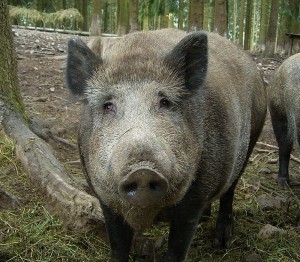 The wild boar is a traditional species in our woods. The Pskov and Novgorod chronicles of 16-17th centuries mention boar hunts. Subsequently, due to the hunts, chases and mass kill in severe winters, the animal disappeared and was absent for almost two centuries. Only in the 1930’s, the wild boar reappeared in the Velikiye Luki district. In 1945 and later on, encounters were reported in the Pskov, Porkhov, Palkino, Gdov and other districts of the region. The boar spread into the region from the west, as a result of its natural eastward expansion. At present, wild pigs inhabit the entire region and are most numerous in southern districts. According to the data of 1980-90’s, the livestock numbers are within 6-7 thousand species.
The wild boar is a traditional species in our woods. The Pskov and Novgorod chronicles of 16-17th centuries mention boar hunts. Subsequently, due to the hunts, chases and mass kill in severe winters, the animal disappeared and was absent for almost two centuries. Only in the 1930’s, the wild boar reappeared in the Velikiye Luki district. In 1945 and later on, encounters were reported in the Pskov, Porkhov, Palkino, Gdov and other districts of the region. The boar spread into the region from the west, as a result of its natural eastward expansion. At present, wild pigs inhabit the entire region and are most numerous in southern districts. According to the data of 1980-90’s, the livestock numbers are within 6-7 thousand species.
Most often, wild boars in small sounders settle in forest outliers and its edges, as well as in thick shrubs adjacent to riverbanks, lakeshores, swamps, and agricultural lands. Being omnivorous, wild pigs rootle for food in search of roots, stocks and shoots of many a plant. They exterminate numerous insects – grubs and wireworms, and they prey on mouse-like rodents, earthworms, and mollusks. They forage on grain and potato fields, at vegetable bunkers – that way harming agriculture. Boars make farrowing pens in the thick of a forest, or by the water. In the winter, they dig a hole in the snow and lay it with dry grass and twigs for resting. In sever winters, many wild boars die of freezing, starvation, disease, and get killed by wolves and poachers. During such years, wild pigs need supplementary feeding.
The wild boar is a valuable game species, yielding meat, hide and hog hair. Boar hunts are licensed in places, where sown fields come to notable harm.
/ * The photos at lake.peipsi.org are cross-posted from commons.wikimedia.org and are used for familiarization purposes only. No commercial use of the photos is allowed. For more information about to use the photos see the originals on commons.wikimedia.org. /


